2013年12月29日
Setouchi Triennale Recap
The verdict is out: Setouchi Triennale 2013 was another resounding success. This year the 108-day contemporary art festival spanned 12 islands plus Takamatsu and Uno ports.
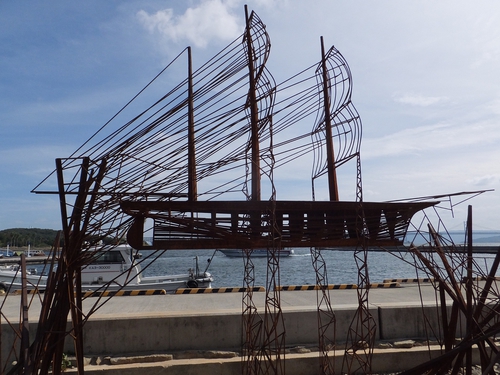
Honjima – Departure by Akira Ishii
According to a report by the Development Bank of Japan, the Triennale attracted 1.07 million visitors (130,000 more than in 2010), and the economic ripple effect is estimated at 13.2 billion yen (up from 11.1 billion yen from 2010). When you consider that the fees charged for access to art sites were extremely low, just the fact that the festival finished in the black is a big accomplishment.
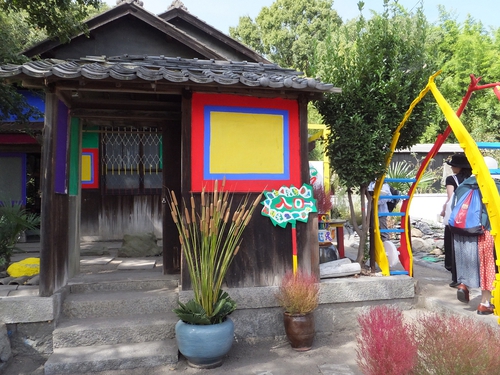
Entrance to Disintegration and Reintegration by Setsuko Mori on Honjima
In addition, the number of artists and islands involved were doubled, and many artists, including a contingent of 100 artists, artisans and performers from Bangladesh, were from overseas.

Prominority member from India on Honjima
According to the General Director, Fram Kitagawa, the number of people in Japan who are hardcore contemporary art fans is at most a few tens of thousands. Yet the Setouchi Triennale drew over a million people. One survey estimated that 1 out of every 100 people in Tokyo had attended.
The Triennale's attraction owes much to the fact that it used contemporary art as a vehicle to entice people to rediscover the islands and a rapidly disappearing way of life.
Kazuko Murao’s Plaster Signboards depicting scenes from the past on Honjima

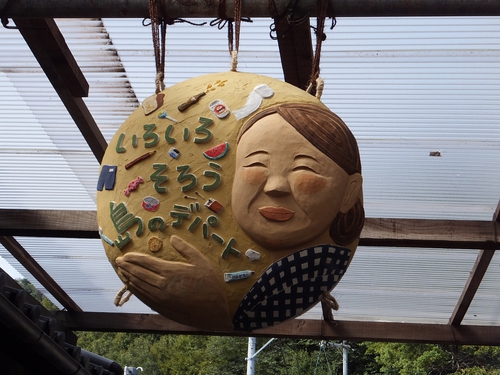
It allowed visitors an escape from the city rat race. It let them experience “slow life” and interact with local people and the natural environment. The response indicates that people in Japan’s urban areas are thirsty for such experience. The fact that 50 percent of visitors from outside Kagawa were women in their twenties and thirties also suggests that going to the Triennale is considered a “cool” thing to do.
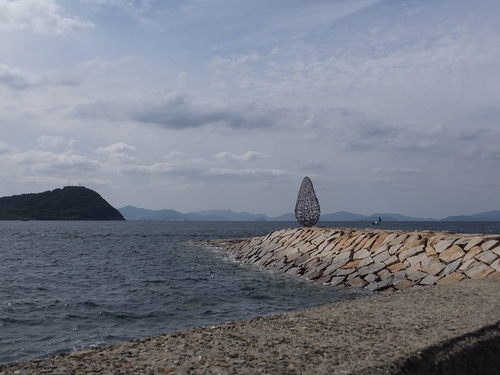
A vine work for Siebold Garden by Karin van de Molin on Honjima
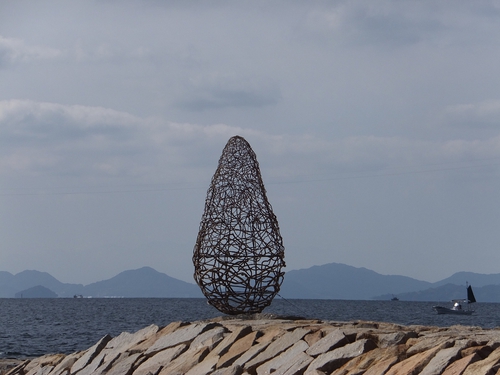
But the true measure of the Triennale’s success must be its effect on the islands and host prefectures. Is it helping to revitalize dying communities? There are no solid data for this yet but I, personally, am hopeful. The residents of those islands that participated in 2010 seemed much more involved in preparations for 2013. Many local “entrepreneurs” stepped up to offer food, accommodation, tours, etc.

Island Soup Honjima by EAT & ART TARO
(I loved this inclusion of new foods made with locally grown ingredients as art!)
A substantial number of local volunteer organizations and companies became enthusiastically involved. The artists also found many ways to involve the local people. The artists’ interpretations of island life, history and nature helped residents see their islands anew, while interaction with many appreciative visitors gave them a glimpse of their area’s potential and hope for the future.


Tinnitus by Jun Homma on Honjima
In addition to site-specific works, most communities also hosted ongoing projects, which are designed to help local residents explore and direct their community’s future. But for me, perhaps the most promising sign was that 3 families from the tiny island of Ogijima were inspired by the Triennale to return with their children. The school, which has been closed for many years, will reopen next year.
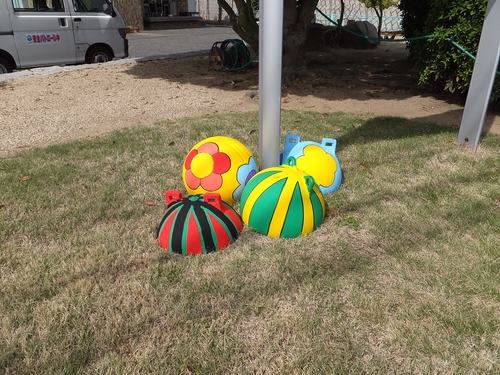
Local buoy art by school children on Honjima
Don’t despair if you missed Setouchi Triennale 2013. Many of the sites are still open to visitors (see http://setouchi-artfest.jp/en/ for more information) and Takamatsu is an ideal base for traveling to the many islands. Just be sure to mark 2016, the year of the next Triennale, on your calendar.
Takamatsu Access:
Takamatsu can be reached by direct flights from Tokyo’s Haneda Airport, by express bus from Kansai International Airport (3 hr), and by direct flights from China and Korea. It can also be reached by taking the bullet train to Okayama and changing to the Marine Liner bound for Takamatsu (runs every 1/2 hour; takes 1 hour). For more info see http://wikitravel.org/en/Takamatsu

Honjima – Departure by Akira Ishii
According to a report by the Development Bank of Japan, the Triennale attracted 1.07 million visitors (130,000 more than in 2010), and the economic ripple effect is estimated at 13.2 billion yen (up from 11.1 billion yen from 2010). When you consider that the fees charged for access to art sites were extremely low, just the fact that the festival finished in the black is a big accomplishment.

Entrance to Disintegration and Reintegration by Setsuko Mori on Honjima
In addition, the number of artists and islands involved were doubled, and many artists, including a contingent of 100 artists, artisans and performers from Bangladesh, were from overseas.

Prominority member from India on Honjima
According to the General Director, Fram Kitagawa, the number of people in Japan who are hardcore contemporary art fans is at most a few tens of thousands. Yet the Setouchi Triennale drew over a million people. One survey estimated that 1 out of every 100 people in Tokyo had attended.
The Triennale's attraction owes much to the fact that it used contemporary art as a vehicle to entice people to rediscover the islands and a rapidly disappearing way of life.
Kazuko Murao’s Plaster Signboards depicting scenes from the past on Honjima


It allowed visitors an escape from the city rat race. It let them experience “slow life” and interact with local people and the natural environment. The response indicates that people in Japan’s urban areas are thirsty for such experience. The fact that 50 percent of visitors from outside Kagawa were women in their twenties and thirties also suggests that going to the Triennale is considered a “cool” thing to do.

A vine work for Siebold Garden by Karin van de Molin on Honjima

But the true measure of the Triennale’s success must be its effect on the islands and host prefectures. Is it helping to revitalize dying communities? There are no solid data for this yet but I, personally, am hopeful. The residents of those islands that participated in 2010 seemed much more involved in preparations for 2013. Many local “entrepreneurs” stepped up to offer food, accommodation, tours, etc.

Island Soup Honjima by EAT & ART TARO
(I loved this inclusion of new foods made with locally grown ingredients as art!)
A substantial number of local volunteer organizations and companies became enthusiastically involved. The artists also found many ways to involve the local people. The artists’ interpretations of island life, history and nature helped residents see their islands anew, while interaction with many appreciative visitors gave them a glimpse of their area’s potential and hope for the future.


Tinnitus by Jun Homma on Honjima
In addition to site-specific works, most communities also hosted ongoing projects, which are designed to help local residents explore and direct their community’s future. But for me, perhaps the most promising sign was that 3 families from the tiny island of Ogijima were inspired by the Triennale to return with their children. The school, which has been closed for many years, will reopen next year.

Local buoy art by school children on Honjima
Don’t despair if you missed Setouchi Triennale 2013. Many of the sites are still open to visitors (see http://setouchi-artfest.jp/en/ for more information) and Takamatsu is an ideal base for traveling to the many islands. Just be sure to mark 2016, the year of the next Triennale, on your calendar.
Takamatsu Access:
Takamatsu can be reached by direct flights from Tokyo’s Haneda Airport, by express bus from Kansai International Airport (3 hr), and by direct flights from China and Korea. It can also be reached by taking the bullet train to Okayama and changing to the Marine Liner bound for Takamatsu (runs every 1/2 hour; takes 1 hour). For more info see http://wikitravel.org/en/Takamatsu
My Profile
Cathy Hirano キャシー ヒラノ
I've lived in Japan since 1978. After graduating from a Japanese university with a BA in cultural anthropology in 1983, I worked as a translator in a Japanese consulting engineering firm in Tokyo for several years. My Japanese husband and I moved to Takamatsu in 1987 to raise our two children in a slower-paced environment away from the big city pressures. We've never regretted it. I work as a freelance translator and interpreter and am involved in a lot of community work, including volunteering for Second Hand, a local NGO that supports educational and vocational training initiatives in Cambodia, and for the Takamatsu International Association. I love living in Takamatsu.
Cathy Hirano キャシー ヒラノ
I've lived in Japan since 1978. After graduating from a Japanese university with a BA in cultural anthropology in 1983, I worked as a translator in a Japanese consulting engineering firm in Tokyo for several years. My Japanese husband and I moved to Takamatsu in 1987 to raise our two children in a slower-paced environment away from the big city pressures. We've never regretted it. I work as a freelance translator and interpreter and am involved in a lot of community work, including volunteering for Second Hand, a local NGO that supports educational and vocational training initiatives in Cambodia, and for the Takamatsu International Association. I love living in Takamatsu.
Posted by cathy at 07:59│Comments(0)
※会員のみコメントを受け付けております、ログインが必要です。





